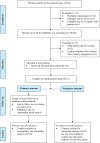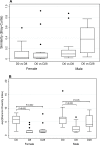Combined oral and topical antimicrobial therapy for male partners of women with bacterial vaginosis: Acceptability, tolerability and impact on the genital microbiota of couples - A pilot study
- PMID: 29293559
- PMCID: PMC5749747
- DOI: 10.1371/journal.pone.0190199
Combined oral and topical antimicrobial therapy for male partners of women with bacterial vaginosis: Acceptability, tolerability and impact on the genital microbiota of couples - A pilot study
Abstract
Objectives: Recurrence following recommended treatment for bacterial vaginosis is unacceptably high. While the pathogenesis of recurrence is not well understood, recent evidence indicates re-infection from sexual partners is likely to play a role. The aim of this study was to assess the acceptability and tolerability of topical and oral antimicrobial therapy in male partners of women with bacterial vaginosis (BV), and to investigate the impact of dual-partner treatment on the vaginal and penile microbiota.
Methods: Women with symptomatic BV (Nugent Score of 4-10 and ≥3 Amsel criteria) and their regular male sexual partner were recruited from Melbourne Sexual Health Centre, Melbourne, Australia. Women received oral metronidazole 400mg twice daily (or intra-vaginal 2% clindamycin cream, if contraindicated) for 7-days. Male partners received oral metronidazole 400mg twice daily and 2% clindamycin cream topically to the penile skin twice daily for 7-days. Couples provided self-collected genital specimens and completed questionnaires at enrolment and then weekly for 4-weeks. Genital microbiota composition was determined by 16S rRNA gene sequencing. Changes in genital microbiota composition were assessed by Bray-Curtis index. Bacterial diversity was measured by the Shannon Diversity Index.
Results: Twenty-two couples were recruited. Sixteen couples (76%) completed all study procedures. Adherence was high; most participants took >90% of prescribed medication. Medication, and particularly topical clindamycin in males, was well tolerated. Dual-partner treatment had an immediate and sustained effect on the composition of vaginal microbiota (median Bray-Curtis score day 0 versus day 8 = 0.03 [IQR 0-0.15], day 0 vs day 28 = 0.03 [0.02-0.11]). We observed a reduction in bacterial diversity of the vaginal microbiota and a decrease in the prevalence and abundance of BV-associated bacteria following treatment. Treatment had an immediate effect on the composition of the cutaneous penile microbiota (median Bray-Curtis score day 0 vs day 8 = 0.09 [0.04-0.17]), however this was not as pronounced at day 28 (median Bray-Curtis score day 0 vs day 28 = 0.38 [0.11-0.59]). A decrease in the prevalence and abundance of BV-associated bacteria in the cutaneous penile microbiota was observed immediately following treatment at day 8.
Conclusion: Combined oral and topical treatment of male partners of women with BV is acceptable and well tolerated. The combined acceptability and microbiological data presented in this paper supports the need for larger studies with longer follow up to characterize the sustained effect of dual partner treatment on the genital microbiota of couples and assess the impact on BV recurrence.
Conflict of interest statement
Figures





References
-
- Taha TE, Hoover DR, Dallabetta GA, Kumwenda NI, Mtimavalye LA, Yang LP, et al. Bacterial vaginosis and disturbances of vaginal flora: association with increased acquisition of HIV. AIDS. 1998;12(13):1699–706. Epub 1998/10/09. . - PubMed
-
- Koumans EH, Kendrick JS, Group CDCBVW. Preventing adverse sequelae of bacterial vaginosis: a public health program and research agenda. Sex Transm Dis. 2001;28(5):292–7. . - PubMed
-
- Martin HL, Richardson BA, Nyange PM, Lavreys L, Hillier SL, Chohan B, et al. Vaginal lactobacilli, microbial flora, and risk of human immunodeficiency virus type 1 and sexually transmitted disease acquisition. J Infect Dis. 1999;180(6):1863–8. Epub 1999/11/24. doi: 10.1086/315127 . - DOI - PubMed
-
- Ness RB, Kip KE, Hillier SL, Soper DE, Stamm CA, Sweet RL, et al. A cluster analysis of bacterial vaginosis-associated microflora and pelvic inflammatory disease. American journal of epidemiology. 2005;162(6):585–90. Epub 2005/08/12. doi: 10.1093/aje/kwi243 . - DOI - PubMed
-
- Fredricks DN, Fiedler TL, Marrazzo JM. Molecular identification of bacteria associated with bacterial vaginosis. N Engl J Med. 2005;353(18):1899–911. Epub 2005/11/04. doi: 10.1056/NEJMoa043802 . - DOI - PubMed
Publication types
MeSH terms
Substances
LinkOut - more resources
Full Text Sources
Other Literature Sources
Medical

